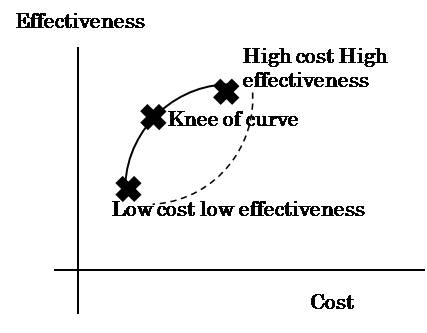Abstract#
SEでは、この費用対効果の高い選択を行っていくことが重要とのことで、授業でものすごい回数繰り返して教授が強調していました。ただし、顧客ごとに要求がことなるため、顧客ごとに答えが違うことに注意。How to#
- Systhesis
| 以下の表を埋めることをSysthesisというらしい。*の部分に必要な機能および一段階分解した機能を書き、その実現方法を3つのパターンで考えていくことらしい |
| Functions | subfuncuion | Alternative1 (low cost low effectiveness) | Alternative2 (knee) | Alternative3 (High cost high effectiveness) | |
| !!! | !!! | # | # | # | |
| !!! | # | # | # | ||
| !!! | # | # | # | ||
| !!! | # | # | # | ||
| !!! | !!! | # | # | # | |
| !!! | # | # | # | ||
| !!! | # | # | # | ||
| !!! | # | # | # |
- Analysis
| Systhesisで行ったことを元に、定量化するのがAnalysisとのこと。Weightは、顧客と相談しながら決める。 |
| Functions | subfuncuion | Weight | Alternative1 (low cost low effectiveness) | Alternative2 (knee of curve) | Alternative3 (High cost high effectiveness) | |
| !!! | !!! | w | score | score | score | |
| !!! | w | score | score | score | ||
| !!! | w | score | score | score | ||
| !!! | w | score | score | score | ||
| !!! | !!! | w | score | score | score | |
| !!! | w | score | score | score | ||
| !!! | w | score | score | score | ||
| !!! | w | score | score | score | ||
| total score | Sum(score!!!weight) | Sum(score!!!weight) | Sum(score!!!weight) |
| そして下記のグラフを書き、基本的には、Knee of curveを選ぶのがよいとされているらしい。ちなみに点線のようになったら、何か間違えていることが多いので計算方法などをやり直した方がいいとか。そうなのかな。。 |
 |
- comments
| ただ、NASAも含めて、政府関連機関などは、予算の制限という絶対的なものがあり、また、できるだけ安くを求められるところもあるので、必ずしもこの考え方がそのまま当てはまるわけではない。まあ、総合評価方式の参考にもなるかな。 |
Reference#
- Eisner, Howard. Essentials of Project and Systems Engineering Management. 3rd ed. Hoboken, N.J.: John Wiley & Sons, 2008
